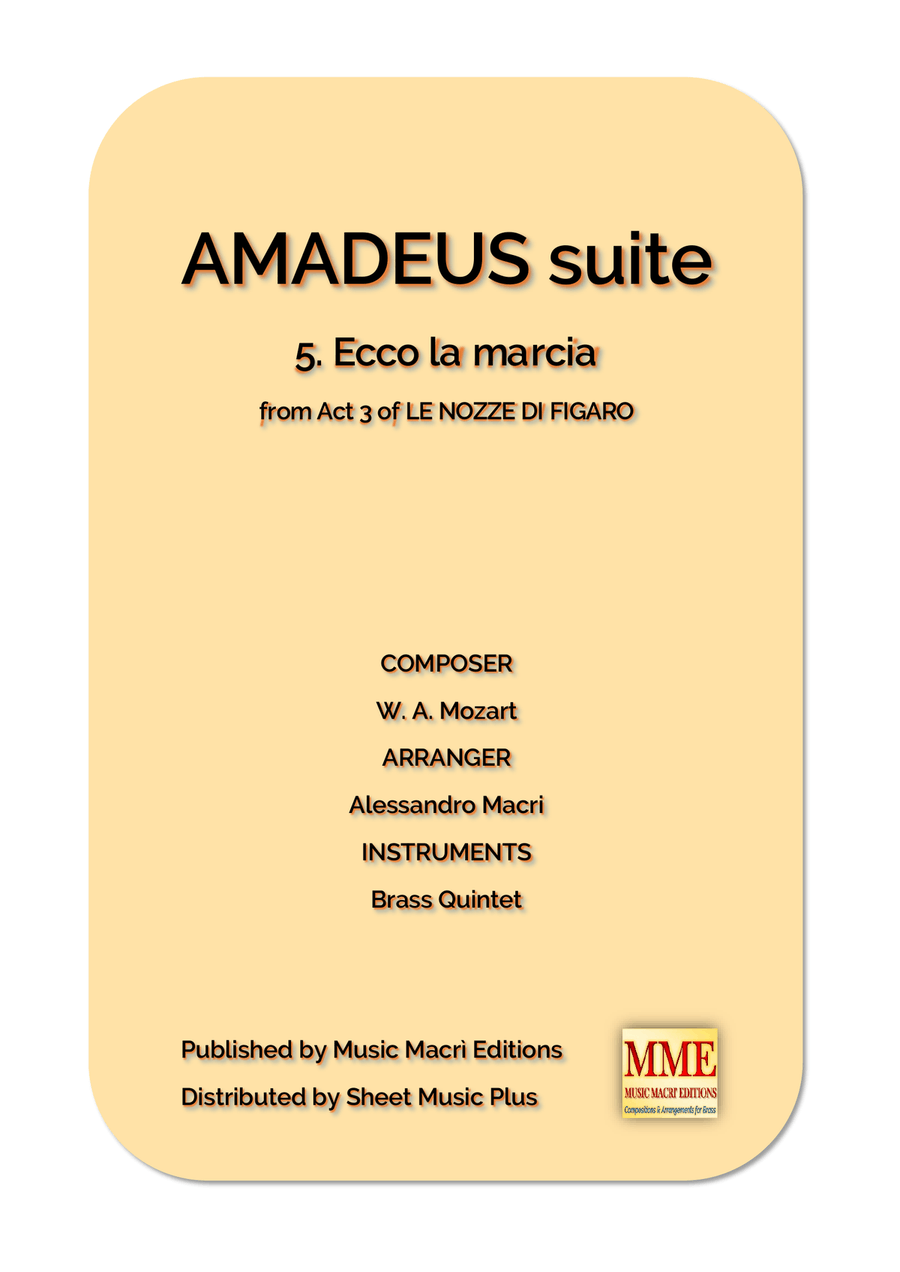Brass Ensemble Horn,Trombone,Trumpet,Tuba - Level 2 - Digital Download SKU: A0.931212 Composed by Wolfgang Amadeus Mozart. Arranged by Alessandro Macrì. Classical. Score and parts. 13 pages. Music Macri Editions #3687655. Published by Music Macri Editions (A0.931212). Le nozze di Figaro, ovvero la folle giornata (K 492) è un'opera lirica di Wolfgang Amadeus Mozart. È la prima delle tre opere italiane scritte dal compositore salisburghese su libretto di Lorenzo Da Ponte.Musicato da Mozart all'età di ventinove anni, il testo dapontiano fu tratto dalla commedia Le nozze di Figaro di Beaumarchais (autore della trilogia di Figaro : Il barbiere di Siviglia , Il matrimonio di Figaro e La madre colpevole ).Dal Terzo Atto - Finale Ecco la marcia, andiamo (Susanna, La Contessa, Il Conte, Figaro; Coro).Le Nozze di Figaro è una delle più famose opere di Mozart e dell'intero teatro musicale, ed è la prima di una serie di felici collaborazioni tra Mozart e Da Ponte, che ha portato anche alla creazione del Don Giovanni e di Così fan tutte .Fu Mozart stesso a portare una copia della commedia di Beaumarchais a Da Ponte, che la tradusse in lingua italiana (tuttora la lingua ufficiale dell'opera lirica) e che (d'accordo con Mozart) rimosse tutti gli elementi di satira politica dalla storia. L'opera fu scritta da Mozart in gran segreto (la commedia era stata vietata dall'imperatore Giuseppe II, poiché attica l'odio tra le varie classi sociali). Questo è un periodo in cui è stato scritto. Eppure è solo dopo aver convinto l'imperatore della rottura delle scene politicamente più discusse che hanno visto il permesso di rappresentare l'opera.Inoltre, la scena finale del terzo atto, che comprendeva un balletto e una pantomima, si dovette scontrare con un divieto imperiale di rappresentare balli in scena. Racconta Da Ponte, nelle sue memorie , che lui e Mozart, non intendono rinunciare al finale come l'avevo concepito, invitarono l'imperatore ad assistere a una prova, dove si sono giocati quel pezzo muto. L'imperatore subito ordinò che la musica fosse reinserita.Così Le Nozze di Figaro , finita di comporre il 29 aprile, fu messa in scena al Burgtheater di Vienna, il 1º maggio 1786 con Nancy Storace (Susanna), Francesco Benucci (Figaro) e Michael Kelly (tenore) (Basilio e Don Curzio) , diretta dal compositore nelle prime due rappresentazioni e da Joseph Weigl nelle repliche. Ottenne un successo strepitoso, al punto che l'Imperatore, dopo la terza recita, dovette emanare un decreto per limitare le richieste di bis, in modo che le repliche non durassero troppo. Ancor più grande fu il successo al Teatro Nazionale di Praga (dal 17 gennaio 1787), colomba (una detta di Mozart): «Qui non sta che che del Figaro, non si suona, non si strombetta, non si canta, non si fischia che il Figaro, non si va a sentire altra opera che il Figaro. Eternamente Figaro! ».L'opera è in quattro atti e ruota attorno alle trame del Conte d'Almaviva, invaghito della cameriera della Contessa, Susanna, alla quale cerca di imporre lo ius primae noctis. La vicenda si svolge in un intreccio serrato e folle, in cui donne e uomini si contrappongono nel corso di una giornata di passione travolgente, piena sia di eventi drammatici che comici, e nella quale alla fine i servi si dimostrano più signori e intelligenti dei loro padroni. L'opera è per Mozart (e prima di lui per Beaumarchais) un pretesto per prendersi gioco delle classi sociali dell'epoca che da lì a poco saranno travolte dai fatti con la Rivoluzione francese. L'intera vicenda può anche essere letta come una metafora delle diverse fasi dell'amore: Cherubino e Barbarina rappresentano l'amore acerbo, Susanna e Figaro l'amore che sboccia, il Conte e la Contessa l'amore logorato e senza più alcuna passione, Marcellina e don Bartolo l'amore maturo.
